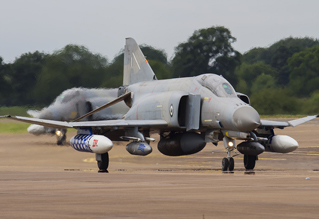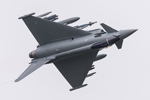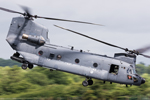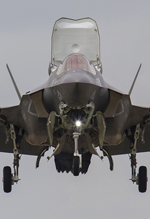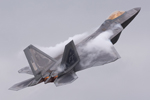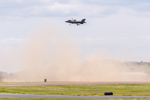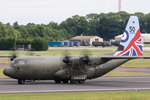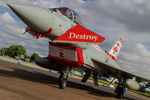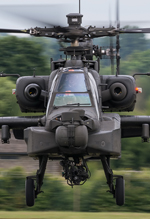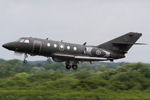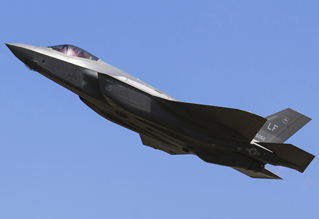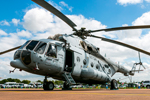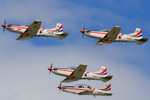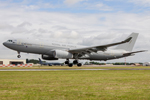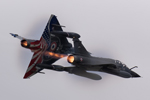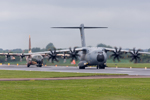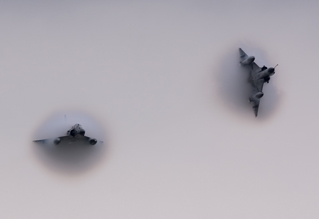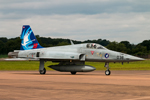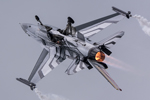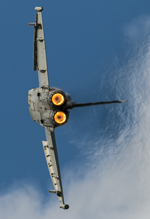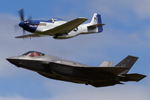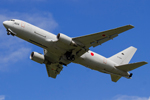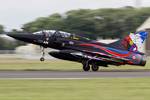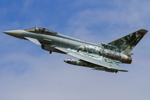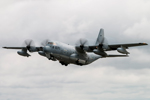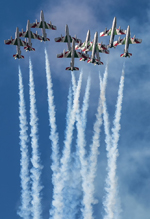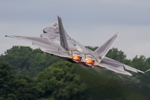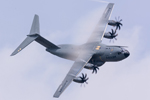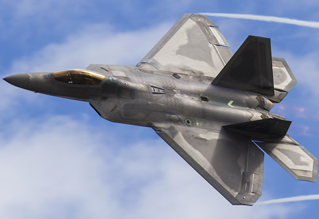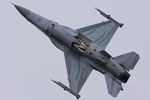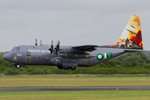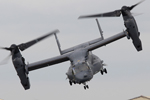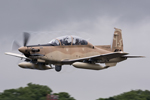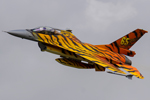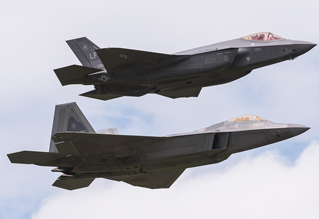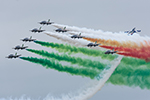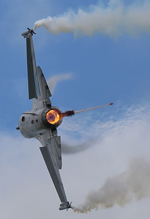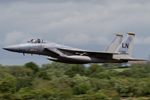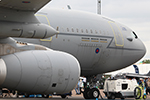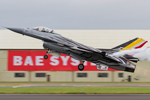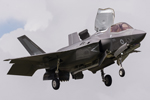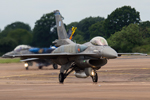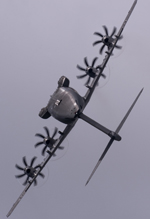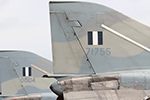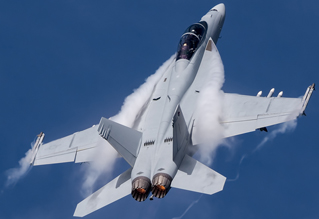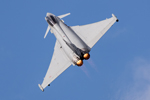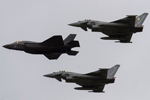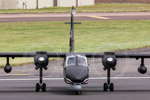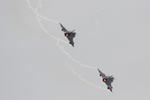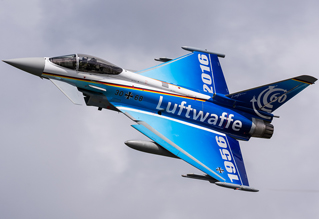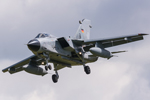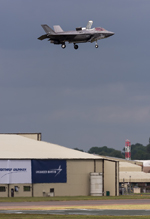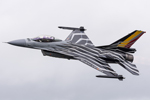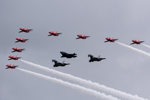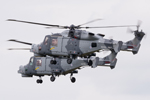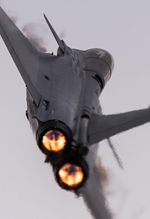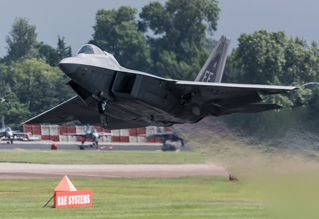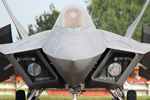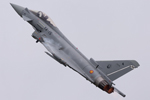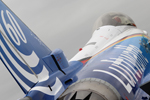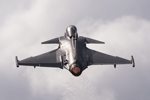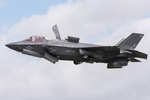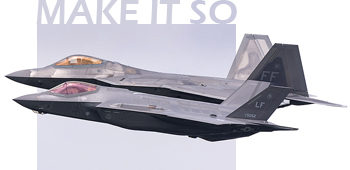
Royal International Air Tattoo Report
Friday 8th July - Sunday 10th July 2016
Held a week earlier than usual due to 2016 being a Farnborough year, this year's Royal International Air Tattoo was placed on a direct collision course with the other major two-day annual airshow in the UK, Flying Legends. Representing the pinnacle of the military airshow, could RIAT stand up and be counted against stiff competition from the premier warbird airshow for the crown of 2016's best UK airshow?
reports from a week-long stint in the FRIAT enclosure. Photography by the UK Airshow Review team.
An Air Tattoo held in an even-numbered year always carries with it a heightened sense of anticipation from those that crave to see the latest military technology in production or in development, thanks to a close working relationship with the Farnborough Air Show. Brought forward by a week to avoid a clash with the trade show in Hampshire, the biennial RIATs that coincide with Farnborough have gained a reputation for attracting prototype examples or the latest versions of some of the world's most advanced military hardware. Couple this reputation with the complementary 2016 theme of 'The Next Generation', and it's clear to see why anticipation was high.
It soon became apparent with each weekly participation update that this theme was being followed to the letter with the announcement of both the USAF F-35A Heritage Flight, RAF/USMC F-35Bs, F-22A Raptors and the F/A-18 Super Hornet, to name but a few. As these next-generation machines were joined by a number of very rare and sought-after aircraft - both static and flying - the show began to attract the interest of more and more enthusiasts.
One cloud that did hang over RIAT 2016 that initially brought an element of uncertainty was the potential fall-out from the Shoreham tragedy. Whilst RIAT is MAA-controlled and therefore not subject to the CAA's recent draconian overhaul of regulations, it was still imperative that Douglas Bader House (DBH) reviewed their own safety procedures. Following discussions regarding liability between DBH and local land owners, the news broke in April that Rhymes Farm, an unofficial viewing site to the north of the airfield, had decided not to open its gates in 2016. The reaction to this news was hysterical, hostile at best, from some parties; many being enthusiasts who chose to spend their money on accessing a field rather than paying it to the RAF Charitable Trust in the name of getting alternative photos.
In reality RIAT 2016 was once again a sell-out, and from the perspective of someone who has spent good money to attend FRIAT, the closure of Rhymes Farm came as nothing but a positive for the future of the show. Up until this year, enthusiasts that had bothered to spend good money to enter the event were left with the prospect of no photos of aircraft on the runway that weren't cluttered with buildings, banners or hundreds of people on stepladders at Rhymes. The now uncluttered fence line at Rhymes came as a breath of fresh air for the general public and FRIAT members alike; from a personal viewpoint it therefore wouldn't be considered a huge loss if Rhymes were to remain permanently closed.
In the grand scheme of things, the events surrounding Rhymes and our views on its future are a sideshow to the main event, the airshow itself. The flying display at RIAT 2016 treated the public to a veritable banquet of fast jet flying displays including no less than four Typhoons (RAF, BAE Systems, Italy and Spain), four F-16s (Belgium, Greece, Poland and Turkey), an F-35A (taking part in the Heritage Flight), an F-35B, an F-22A, F/A-18F Super Hornet, Rafale, Gripen, MiG-29 and the ever-popular Ramex Delta; the appealing pair of Mirage 2000Ns which performed their final ever displays at RIAT. This was acknowledged by the organisers with a water cannon salute provided on the Sunday. They will be a great loss to the European display circuit. Some that attended thought the fast jet emphasis this year was perhaps a little too much, however this is not a statement UKAR agrees with. Visitors were treated to a diverse display of sheer power from nearly every active combat type in the West. Of particular note were the Rafale and SoloTurk who gave some of the most aggressive displays of the weekend: many had thought they had seen everything an F-16 could do until the SoloTurk display on the Saturday left many jaws firmly on the floor! Whilst flown a little high, Nat Makepeace's display on behalf of show sponsor BAE Systems in a Typhoon fully loaded in P3E configuration (two ASRAAMs, four Meteors, two fuel tanks, two Paveway IVs and six Brimstone IIs) impressed, with very little loss in manoeuvrability evident between his display and that of the other nations who flew 'clean'.
Not all fast jet displays were of the same quality however - making its debut at this year's show was the Polish F-16 'Tiger' display. In stark contrast to their colleague's MiG-29 display (which included a tail slide), this felt very far away and not hugely dynamic which was disappointing considering such a well-painted Block 52 F-16C was being used. Similarly, the drably marked Super Hornet performed its Farnborough routine (complete with a high base height ruining its impact) - it was also disappointing to yet again see a two-seat F model appear at RIAT when a single-seat E model had also validated at Farnborough the week prior.
Of course these were not the only display acts of note. Making their UK display debut were Croatia with their popular Wings of Storm display team flying the Pilatus PC-9M; their display was well received by many, however they were one of many acts that suffered with uninspiring weather during their slot time. Other international teams attending included Team Orlik, Patrouille Suisse and Frecce Tricolori; the latter performing for the last time on the MB339. The Patrouille Suisse recently suffered an accident and were flying as a five-ship whilst their team-mate recovered. However their run of bad luck continued at RIAT, performing as a four-ship on Saturday due to illness and a taxying display on Sunday, the low cloud base preventing them from even getting airborne. Adding a touch of variety to the flying display were the ever-popular Airbus A400M, Royal Navy Black Cats (performing at RIAT for the first time since upgrading to Wildcats), and the USAF CV-22B Osprey - all of which never cease to amaze the crowds. These were also joined by the final ever UK appearance of the MBB Bo-105 of the German Army, offering its lively aerobatic routine for the second successive year.
During the build-up to the show three key flying stars emerged, all fitting very nicely with the 'The Next Generation' theme. Expanding on the original 2014 plan to bring the F-35B to the UK, not only did news break that three F-35Bs would be present at RIAT (including one RAF example) but that the show had been chosen for the international debut of the USAF F-35A Heritage Flight together with the return of the much loved F-22A Raptor demonstration team, last seen at the show in 2010. As well as the F-22A performing its awesome daily routine, it was also scheduled to join the F-35A and P-51D Mustang 'Miss Helen' in the Heritage Flight. Sadly, thanks to the weather and technical difficulties, the crowd did not get to see all three aircraft together in formation - instead, both fifth generation aircraft flew together on Friday and Saturday whilst the F-35A performed with 'Miss Helen' on Sunday.
Recently enthusiasts have witnessed the KLu provide the general public with an idea of the capability of the F-35A via a well-received, powerful combat demonstration and therefore we looked forward to seeing what the F-35B could do. Aside from the addition of a vertical landing, a flypast with the Red Arrows and (on the Friday) a very brief Air to Air Refuelling demonstration; the display shown to crowds at RIAT was a carbon copy of the USMC display witnessed at Miramar in October 2015 except for one key factor - the UK display lacked aggression. Whereas in California the take-off was followed by an immediate aggressive full reheat turn, the UK take-off saw reheat being de-selected upon rotation with an extended time passing before turning away from the crowd. The trend also continued throughout the display: the Miramar display saw turns with vapour using reheat, but the Fairford display only included turns at dry power without the resultant vapour. The fascinating part of the display for the spectator however was the hover at crowd centre (destroying the datum markers on the Saturday!) which exemplified how much more stable the aircraft is in vertical flight than the Harrier, even if it did squeal like a pig! The welcome addition of the vertical landing was unique, and following the significant FOD issue caused during the Wednesday practice, the resultant need for the ground to be damp gave the fire crews some daily practice with their water hoses prior to the display! Despite these shortcomings it was still great to finally see them on UK shores and it was a nice touch for the aircraft to be towed over every day to the end of the Red Zone so spectators could get a closer look at the machines.
On the ground, the 2016 static display oozed a level of quality and rarity that we haven't seen for a number of years. The undoubted stars had to be the pair of F-4E Phantom IIs from 339 Mira of the Hellenic Air Force and it was clear the crews knew how rare their appearance was from the abundance of special merchandise brought along! Other highlights from one of the best static displays of recent times included the very welcome addition of the Royal Australian Air Force with their KC-30, a Luftwaffe A400M, RNZAF 757, Croatian Mi-171 and the welcome return of the Japanese KC-767J. It was disappointing to see the Textron elements of the static depart early on the Sunday morning for Farnborough - compounded by the fact that when questioned, they stated that their marketing department had prevented them from bringing any publicity material with them to RIAT, almost as if their participation had been an afterthought by the company. One especially pleasing aspect of this year's static was the layout, there was plenty of space to take photos without too much clutter behind on the whole - we hope this trend continues in following years.
As has been highlighted by a number of members of the UKAR forum, it would be wrong if the apparent decline in static was completely ignored. The static display did seem thinner than previous years - perhaps the smallest seen in recent times although easily offset this year by the sheer quality of what was on display. The question that does need to be explored is why is the number of static aircraft are apparently in decline?
There doesn't appear to be a single answer to this riddle, however UKAR do believe that it is not the fault of anybody at DBH - quite the contrary in fact, as they try their utmost every year to attract what we want to see and in significant numbers. If a finger had to be pointed at a majority reason for the reduction in static items however, it would be pointed firmly at the RAF. There does appear to be a noticeable trend between the very few (and possibly still reducing) international appearances by the RAF at airshows and the number of international assets reciprocating participation at major UK airshows, especially statically. UKAR firmly believe that until the RAF change their attitude and begin supporting international airshows more greatly, the worse the situation will become.
One of the more popular initiatives introduced over recent years has been the 'Pit' access on a Friday morning. Being able to get close to flying participants, particularly the Red Arrows and - this year - the F-22A Raptors, has always been keenly appreciated. However in 2016, the number of aircraft in the 'Pit' seemed to be lacking. It seemed strange that despite the RAF fast jets (and Raptors), that the fast jets had been parked at the Western end and the international display teams on the Northern side of the airfield. With the F-35s being towed to the end of the Red Zone outside of the 'Pit' hours would explain some of the need for this extra space in order to satisfy security precautions however there did seem to be a significant amount of empty space where some of the international teams could have been parked, for example.
The Friends of the Royal International Air Tattoo (FRIAT) enclosure, and it's prime piece of crowdline at display centre, is seen by many enthusiasts as the only way to watch RIAT. Indeed many consider it an annual pilgrimage. This year saw a number of changes to FRIAT and its enclosure, some welcome and one far less so. DBH have now introduced a loyalty scheme for the next three years meaning that those who renew their FRIAT membership in 2016, 2017 and 2018 will not pay more as the price for new members increases - for now at least. A positive improvement over 2015 was more provision for when validations were required on the Thursday afternoon. Last year when the FRIAT enclosure was closed early on the Thursday, members on foot were unfairly forced to leave the airfield and make their own way to the P&V areas or miss the remainder of the days flying. This year we are pleased to report that concerns regarding this were taken on-board and a shuttle bus was available to those members of FRIAT on foot who wished to use it. As it happened, due to the weather conditions that afternoon and the poor photographic opportunities available as a result, many FRIAT members chose to end their day when the enclosure closed rather than use the shuttle bus. Nevertheless this was a very welcome addition, and we hope this will return again next year if the need arises. An additional surprise improvement this year was the size of the enclosure perimeter - the compound is still of a similar length but is now much deeper (stretching further south). The now abundant amount of space behind the grandstand gave ample room for people to relax and have a break when not in the melee that was the grandstand.
This brings us to what was RIATs' primary 2016 issue - the FRIAT grandstand itself. As explained at the FRIAT Forum in April, the capacity and length of the grandstand was increased for 2016, however, this appeared to have been at the expense of the comfort of loyal FRIAT members. Traditionally, the grandstand used by FRIAT has benefitted from seating of a width ample enough to allow photographers free movement with their lenses - something of a unique requirement for airshow grandstands given the immense array of angles people in the stand may be panning to, unlike other non-aviation events where the subject matter may be more stationary- plus ample storage space/legroom below the seats to allow the members a week in relative comfort; those on row A typically received a storage 'shelf' behind their seats in order to keep the walkway clear. All these benefits vanished with 2016's expanded grandstand, there was no space to swing a frog (they're smaller than a cat!) let alone a camera lens; the width of the seats were tiny for the larger-framed individual which, if we're honest, constitutes a large percentage of the FRIAT membership - as a result, people were crammed-in like sardines, unable to move very much whatsoever. Not a pleasant experience. The lack of storage space on row A also formed a trip hazard for those standing - encouraging them to stand further out into the aisle. There was also a noticeable gap below each seat resulting in a significant increase in the number of dropped items falling to the ground below, thankfully we didn't hear of a camera taking a dive! In short, this year's FRIAT grandstand was not fit for purpose.
After speaking with the FRIAT management together with other senior DBH figures; we are pleased to advise that the issue with the grandstand has certainly been recognised. It's understood the issue has been caused by the use of a new contractor and it is therefore hoped that the situation will be rectified for next year. As the saying goes, the proof of the pudding is in the eating and therefore we await FRIAT 2017 with great interest.
As a final FRIAT note, and something that is recognised to be out of the organiser's hands by a large margin, is the declining levels of etiquette being shown in the grandstand. This year, no forethought was given by many as to when they stood up or moved around the grandstand, many trying to rush back to their seat only to stand like (for want of a better word) muppets in the aisles blocking people's shots of take-offs and landings. That said, those that did time their movements well still found themselves sworn at by others (at least one UKAR staffer was sworn at during the event), another staffer witnessed someone throwing a bottle at another FRIAT member (a complete stranger) who was being asked to sit down. One wonders if this could be investigated further. Of note, another increasing behaviour was from individuals in mid rows trying to bully their way into empty space on Row A at the detriment of the view for those who get up early on a Thursday to obtain their coveted place and are sitting in their allotted seat, even getting quite aggressive when asked to move. This behaviour is clearly not acceptable, but it's not an easy problem to solve.
When all has been said, RIAT 2016 was in our opinion the best event we have witnessed in the UK for a number of years - DBH got the mix of flying and high-quality static just about right. Apart from the FRIAT issue raised above there weren't any major faults with the show to be found that wouldn't have been classed as nit-picking. This includes the decision to celebrate the Air Cadets 75th Anniversary on the ground rather than in the air being considered as the right one to make in order not to disjoint the flying display. Initial feedback on our forums would support this view although it does seem many of our members experienced car parking issues on Red Route, particularly on the Saturday, which may need addressing next year. In addition, our members would ideally love to see the showground remain open an extra half an hour to allow the static to be shot without crowds - how possible this is we do not know and is something we will be happy to raise with DBH on their behalf.
The UKAR staff team left RIAT 2016 with smiles on faces. DBH got things right this year and it's our hoped that the show will once again grow in strength in 2017. RIAT is without doubt the best airshow in the UK in 2016.
Next year's event will celebrate the 70th Anniversary of the US Air Force; our imaginations are already running wild with possibilities but in reality, let's just hope for one thing that wasn't available this year and that is good weather! In the words of Captain Picard from Star Trek: The Next Generation - Make It So.

